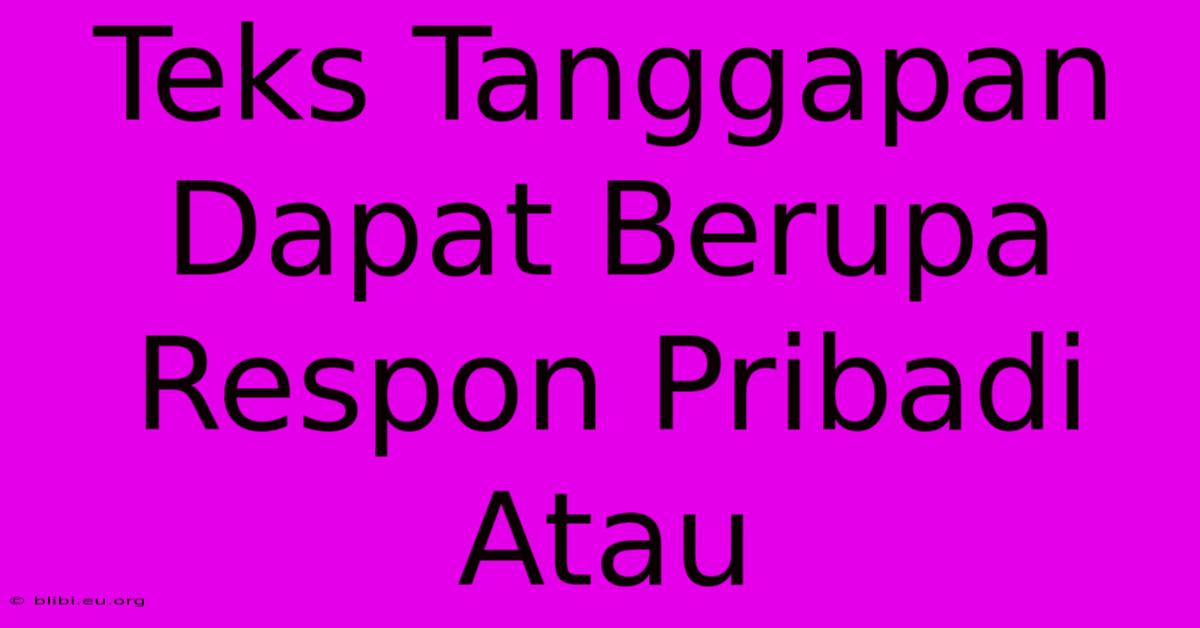Teks Tanggapan Dapat Berupa Respon Pribadi Atau

Discover more detailed and exciting information on our website. Click the link below to start your adventure: Visit Best Website blibi.eu.org. Don't miss out!
Table of Contents
Teks Tanggapan: Dapat Berupa Respon Pribadi atau Umum?
Understanding how to write effective responses is crucial in many aspects of life, from personal communication to professional settings. This article explores the nuances of teks tanggapan, which translates to "response text" in English, and clarifies when a personal or general response is most appropriate. We'll delve into the characteristics of each, providing practical examples to guide you.
Personal Responses: Showcasing Empathy and Individuality
A teks tanggapan pribadi (personal response text) is characterized by its unique and tailored approach. It focuses on the specific context and relationship between the sender and receiver. This type of response is best suited for situations where a close, personal connection exists, requiring empathy and a genuine understanding of the individual's perspective.
Key characteristics of a personal response:
- Empathetic and understanding: Acknowledges the recipient's feelings and experiences.
- Specific and tailored: Directly addresses the points raised in the initial communication.
- Informal and conversational: Uses language suitable for the relationship.
- May include personal anecdotes or experiences: To create a stronger connection.
Example:
Imagine a friend shares news of a challenging situation. A personal response might look like this:
"Hey [Friend's Name], I'm so sorry to hear about what you're going through. That sounds incredibly tough. Remember that time we [shared experience]? You got through that, and you'll get through this too. Let me know if there's anything at all I can do – whether it's lending an ear, grabbing coffee, or just being there for you."
General Responses: Maintaining Professionalism and Efficiency
A teks tanggapan umum (general response text) prioritizes clarity, conciseness, and professionalism. It's often used in formal settings or when addressing a wide audience. While it lacks the personalized touch of a personal response, it ensures consistent messaging and efficient communication.
Key characteristics of a general response:
- Formal and professional: Uses appropriate language and tone.
- Concise and to the point: Avoids unnecessary details or rambling.
- Objective and unbiased: Focuses on factual information.
- Consistent messaging: Maintains a uniform tone and style across all responses.
Example:
Consider a company responding to customer inquiries about a product feature. A general response might say:
"Thank you for contacting us regarding [product feature]. We understand your inquiry. [Feature description] works by [explanation of functionality]. For further assistance, please visit our FAQ page at [link – note: per instructions, this link is omitted]. If you have further questions, please don't hesitate to contact us again."
Choosing the Right Approach: Context is Key
The choice between a personal and general response depends heavily on the context. Consider these factors:
- Your relationship with the recipient: Are you communicating with a friend, family member, colleague, or stranger?
- The nature of the communication: Is it a casual conversation or a formal request?
- Your intended purpose: Are you aiming to build rapport, provide information, or resolve a problem?
By carefully considering these factors, you can craft effective teks tanggapan that achieve your communication goals. Remember, tailoring your response to the situation is crucial for effective and appropriate communication.

Thank you for visiting our website wich cover about Teks Tanggapan Dapat Berupa Respon Pribadi Atau. We hope the information provided has been useful to you. Feel free to contact us if you have any questions or need further assistance. See you next time and dont miss to bookmark.
Featured Posts
-
Sinonim Dari Kata Cakap Adalah
Nov 17, 2024
-
Rumus Fungsi Polinom Berderajat 0 Juga Disebut
Nov 17, 2024
-
Sebutkan Empat Ciri Latihan Kelenturan
Nov 17, 2024
-
Sinonim Dari Kata Alami Yaitu
Nov 17, 2024
-
Sinonim Kata Unik Adalah
Nov 17, 2024
-
Teks Tanggapan Dapat Berupa Respon Pribadi Atau
Nov 17, 2024
